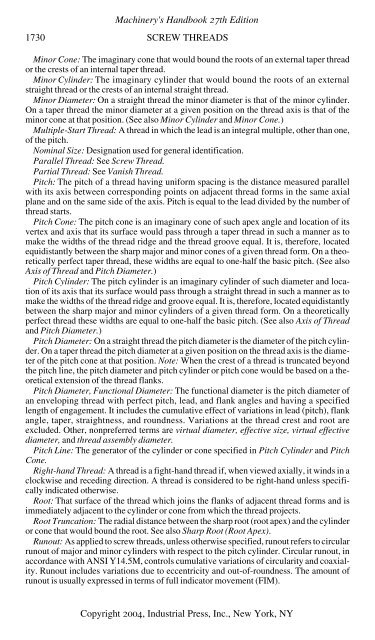Threads and Threading - Sportpilot.info
Threads and Threading - Sportpilot.info
Threads and Threading - Sportpilot.info
You also want an ePaper? Increase the reach of your titles
YUMPU automatically turns print PDFs into web optimized ePapers that Google loves.
Machinery's H<strong>and</strong>book 27th Edition<br />
1730 SCREW THREADS<br />
Minor Cone: The imaginary cone that would bound the roots of an external taper thread<br />
or the crests of an internal taper thread.<br />
Minor Cylinder: The imaginary cylinder that would bound the roots of an external<br />
straight thread or the crests of an internal straight thread.<br />
Minor Diameter: On a straight thread the minor diameter is that of the minor cylinder.<br />
On a taper thread the minor diameter at a given position on the thread axis is that of the<br />
minor cone at that position. (See also Minor Cylinder <strong>and</strong> Minor Cone.)<br />
Multiple-Start Thread: A thread in which the lead is an integral multiple, other than one,<br />
of the pitch.<br />
Nominal Size: Designation used for general identification.<br />
Parallel Thread: See Screw Thread.<br />
Partial Thread: See Vanish Thread.<br />
Pitch: The pitch of a thread having uniform spacing is the distance measured parallel<br />
with its axis between corresponding points on adjacent thread forms in the same axial<br />
plane <strong>and</strong> on the same side of the axis. Pitch is equal to the lead divided by the number of<br />
thread starts.<br />
Pitch Cone: The pitch cone is an imaginary cone of such apex angle <strong>and</strong> location of its<br />
vertex <strong>and</strong> axis that its surface would pass through a taper thread in such a manner as to<br />
make the widths of the thread ridge <strong>and</strong> the thread groove equal. It is, therefore, located<br />
equidistantly between the sharp major <strong>and</strong> minor cones of a given thread form. On a theoretically<br />
perfect taper thread, these widths are equal to one-half the basic pitch. (See also<br />
Axis of Thread <strong>and</strong> Pitch Diameter.)<br />
Pitch Cylinder: The pitch cylinder is an imaginary cylinder of such diameter <strong>and</strong> location<br />
of its axis that its surface would pass through a straight thread in such a manner as to<br />
make the widths of the thread ridge <strong>and</strong> groove equal. It is, therefore, located equidistantly<br />
between the sharp major <strong>and</strong> minor cylinders of a given thread form. On a theoretically<br />
perfect thread these widths are equal to one-half the basic pitch. (See also Axis of Thread<br />
<strong>and</strong> Pitch Diameter.)<br />
Pitch Diameter: On a straight thread the pitch diameter is the diameter of the pitch cylinder.<br />
On a taper thread the pitch diameter at a given position on the thread axis is the diameter<br />
of the pitch cone at that position. Note: When the crest of a thread is truncated beyond<br />
the pitch line, the pitch diameter <strong>and</strong> pitch cylinder or pitch cone would be based on a theoretical<br />
extension of the thread flanks.<br />
Pitch Diameter, Functional Diameter: The functional diameter is the pitch diameter of<br />
an enveloping thread with perfect pitch, lead, <strong>and</strong> flank angles <strong>and</strong> having a specified<br />
length of engagement. It includes the cumulative effect of variations in lead (pitch), flank<br />
angle, taper, straightness, <strong>and</strong> roundness. Variations at the thread crest <strong>and</strong> root are<br />
excluded. Other, nonpreferred terms are virtual diameter, effective size, virtual effective<br />
diameter, <strong>and</strong> thread assembly diameter.<br />
Pitch Line: The generator of the cylinder or cone specified in Pitch Cylinder <strong>and</strong> Pitch<br />
Cone.<br />
Right-h<strong>and</strong> Thread: A thread is a fight-h<strong>and</strong> thread if, when viewed axially, it winds in a<br />
clockwise <strong>and</strong> receding direction. A thread is considered to be right-h<strong>and</strong> unless specifically<br />
indicated otherwise.<br />
Root: That surface of the thread which joins the flanks of adjacent thread forms <strong>and</strong> is<br />
immediately adjacent to the cylinder or cone from which the thread projects.<br />
Root Truncation: The radial distance between the sharp root (root apex) <strong>and</strong> the cylinder<br />
or cone that would bound the root. See also Sharp Root (Root Apex).<br />
Runout: As applied to screw threads, unless otherwise specified, runout refers to circular<br />
runout of major <strong>and</strong> minor cylinders with respect to the pitch cylinder. Circular runout, in<br />
accordance with ANSI Y14.5M, controls cumulative variations of circularity <strong>and</strong> coaxiality.<br />
Runout includes variations due to eccentricity <strong>and</strong> out-of-roundness. The amount of<br />
runout is usually expressed in terms of full indicator movement (FIM).<br />
Copyright 2004, Industrial Press, Inc., New York, NY













